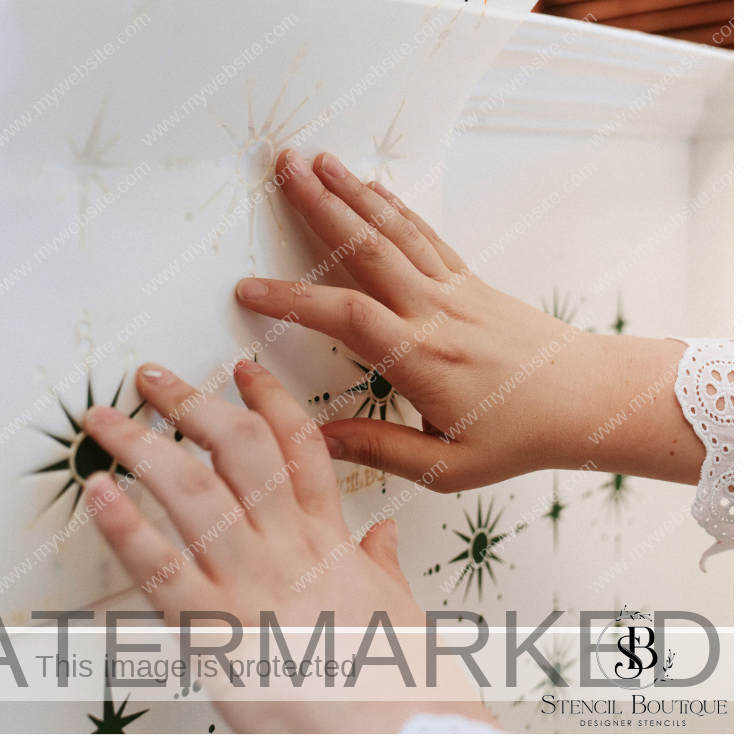
Stencils make creating home decor doable and affordable. Enjoy carefree crafting and allow the designs to inspire you as you scroll down the page.

Before you start stencilling, it is crucial that the walls are properly prepared. Here are some tips to help ensure the best possible outcome:
By following these tips, you can ensure that your stencil design will look its best and last for a long time.

Achieving a clean and professional look when stencilling is crucial. Here are some techniques to keep in mind:

Base paint
For a smooth, even finish, we recommend base coating your walls with a water-based paint in a flat sheen using a tight nap roller. This type of paint is ideal for stencilling because it accepts the stencil paint more readily than shinier paints, resulting in a crisper print. Porous by nature, flat sheen paint allows the stencil paint to adhere without bleeding/seeping under the edges of the stencil. Plus, flat paints are easier to touch up because they blend better without causing flashing (an uneven sheen that appears when attempting to touch up higher-sheen paints like semi-gloss). If you make a mistake while stencilling, simply paint over the mistake with a flat sheen paint and re-stencil the area for perfect results.
Stencil Paint
When it comes to walls, we suggest using high-quality acrylic or water-based paint. Craft acrylics are also an excellent choice. However, we advise against using spray paint as it can be challenging to control. Additionally, oil-based paints are not stencil-friendly. You can use metallic paint, glaze, or plaster for stencilling purposes.
Choosing the right color combinations can be challenging, but it doesn’t have to be. Look for references that offer examples of color schemes that complement each other. Before making a final decision, do a test sample to see if you are comfortable with your choices. Keep in mind any pre-existing fabrics, floor or carpet colors, and use white index cards for color swatches – they’re a great resource!

Consider the following benefits of testing your colour scheme and technique before stencilling your wall:
Perfect your stencilling technique and achieve the ideal result. Our sample boards are available for purchase under “Stencil Supplies”.


To begin, place your stencil on the wall in your desired location. Use several strips of low-tack masking tape to secure the stencil in place. If you require a level stencil, use a regular leveller to ensure it’s straight. While plain designs do not require levelling, wall or seamless pattern stencils benefit from it to properly align the elements.
Stencilling Ceilings: Follow the same process as before, but we recommend using a spray adhesive in addition to low tack masking tape to hold the stencil in position. When choosing an adhesive spray, be sure to select one that is non-staining and repositionable. This will ensure that the walls remain free of stickiness. You can easily find this product either at your local craft store, hardware store or online. Simply spray the back end of the stencil and you’re good to go!
Achieve perfect stenciling results with this quick and easy technique, perfect for walls! Here’s how to do it:


Stencil bleed is a common issue when using stencils; paint seeps under the edge, resulting in an imperfect print. While it’s impossible to avoid all bleeding, there are measures you can take to reduce it significantly. Keep in mind that once the wall is completed, the overall effect will be stunning, and minor bleeds won’t be noticeable. To minimize bleed, consider following these guidelines:

If you’re looking to achieve precise designs on furniture, craft projects, or even walls, using a stencil brush is the way to go! With the Dry-Brushing technique, your design will turn out so flawless that it’ll appear as if it were printed. Although using a stencil brush may take longer than other methods, the end result is a crisper design with no bleed. Here’s how you can use a stencil brush:
Practice makes perfect! Keep honing your dry-brushing skills and watch as your stencil design springs to life before your very eyes.

When working on a seamless wall, floor or tile stencil project, we recommend using more than one stencil. Not only will this accelerate the process, it also allows you to cut one stencil into smaller pieces that will fit perfectly into corners, mouldings or edges, without having to bend the stencil. This nifty technique often results in a superior finish, complete with sharp, clean edges. Here are some steps for using seamless stencils:


Here are some helpful tips to make your next painting project a success:
WhatsApp us